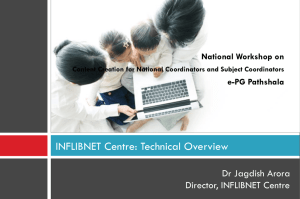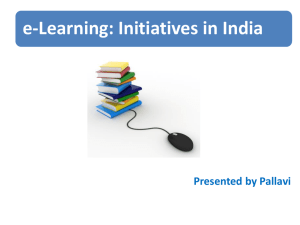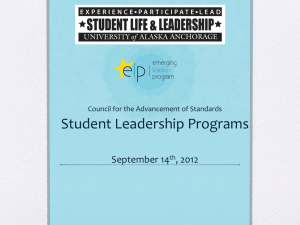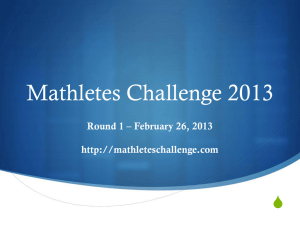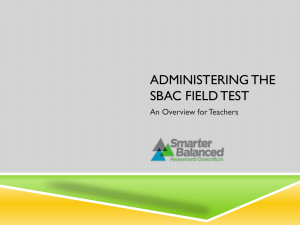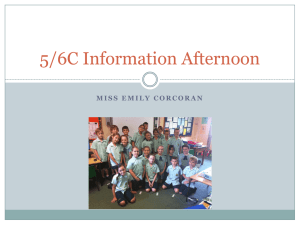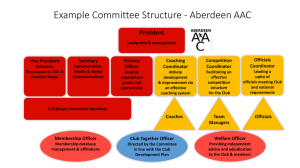Prof A K Bakhshi
advertisement
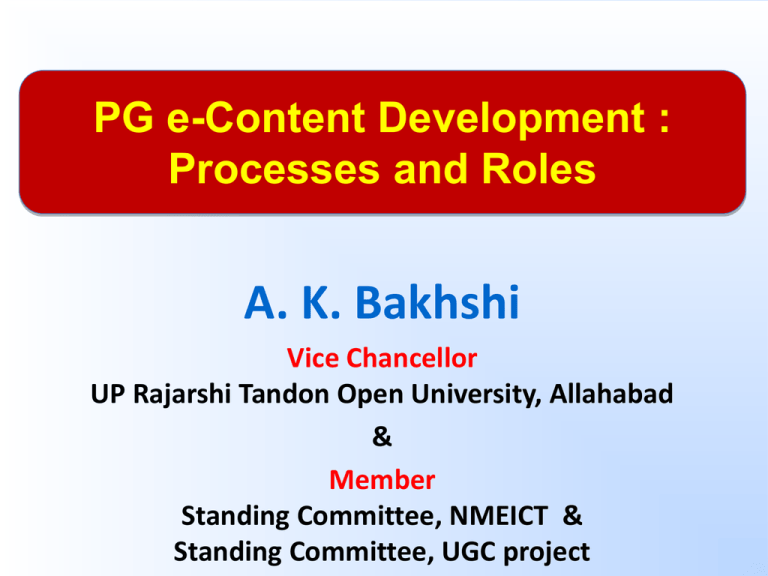
PG e-Content Development : Processes and Roles A. K. Bakhshi Vice Chancellor UP Rajarshi Tandon Open University, Allahabad & Member Standing Committee, NMEICT & Standing Committee, UGC project About the Project UGC project sanctioned by MHRD, Government India under NMEICT scheme To develop e-content for PG courses in 77 subjects As per mainly UGC Curriculum About the Project Total budget for the project: Rs 84 crores To be hosted on a Portal named e-PG Pathshala developed and maintained by Inflibnet, a UGC Interuniversity Centre. NMEICT National Mission on Education through ICT is an ambitious project of the Govt. of India with a focus on Catering to the learning needs of more than 50 crore Indians providing ICT enabled education in the country making higher education more accessible increasing the present Gross enrolment ratio (12%) to at least the World average (22-23%) NMEICT KeyFocus FocusAreas Areas NMEICT-– Key Development of e-content Infrastructure and connectivity at the National level Broad Objectives Teacher and Student empowerment in ICT Imperatives Objectives of NMEICT should be achieved as early as possible Of all the objectives, the biggest challenge is in developing high quality, multi-media enriched e-content, its multi-lingual conversion, if required. It’s a race against time. Things can’t be given infinite time for completion. Magnitude of the work involved No. of Subjects/Disciplines 77 No of papers 77 x 16 = 1232 (Assuming 16 semester papers per discipline spread over two years) No. of Modules in 1 Subject 35 x 16 = 560 (Assuming 35 modules per semester paper , 1 module consisting of 1 hour lecture) Total No. of Modules in 77 Subjects 560 x 77 = 43,120 Importance of e-Learning in Higher Education It is an answer to growing demand for enrolments in Higher education e-Learning is more in tune with the mindset of the present day students It offers solution to the challenges of growth of knowledge in different Disciplines Importance of e-Learning in Higher Education Helps in improving the Quality of Education imparted to the students e-Learning Can supplement the Traditional mode of Teaching and Learning To Empower Teachers and not to replace them! Traditional Teaching Methodology What to do ? Chalk and talk method Though it has many advantages, yet it is not without limitations Limitations of Talk and Chalk Method of Teaching Teachercentric approach Presumes that all the students learn in identical fashion. Monologue method Limitations of Talk and Chalk Method of Teaching Slow and time consuming Many complex concepts cannot be explained Due to paucity of time, sufficient number of problems can’t be tackled in class Importance of e-Learning in Higher Education For Conventional Universities e – Learning should be viewed as a Supplement to Traditional Learning And definitely not its replacement ! For Virtual Universities As the main way of Learning SCOPE of e-Learning For Open and Distance Education Universities As a better alternative as compared to present day selflearning (using printed material) What is e-content? e-PG Pathshala • Aim of the project is the development of e-content and not merely content for postgraduate disciplines/subjects What is e-content? Static Content Text Images/Graphics Multimedia enrichment Audio Video Animation Simulations Interactivity eContent Self – Learning Self-Assessment SCORM compliant SCORM Compliant Authentic Selflearning Reusable Modular Good e-content Selfassessment Highly interactive Easy navigation Structured Multimedia enriched What should e-content include? Each Semester Paper of 40 hour duration to have 35 modules Content to be developed as per NMEICT Four Quadrant Approach e-PG Pathshala: Form of econtent in each Module E-Text Detailed Text / Lesson Self-Assess Self graded e-Quizzes with feedback Self-Learn Audio Lectures having text, animations and videos Learn More Value additions for more self learning Amount of e-content per Module E-Text Self-Learn Detailed explanation of the topic(s) as Text and images/graphics Minimum 10 slides of Ppt with audio script Audio to be recorded after reviewing and editing Minimum 6 A-4 pages Animation Story Board Amount of e-content per Module Self-Assess Subjective Questions: Minimum 3 Objective Questions: Minimum 5 (MCQ, True-False, Match, Fill in the blank, etc.) Know More Value Additions Minimum 6 • Glossary • References/ suggested readings • Web-links • Did you know • Interesting facts • Timelines • Case-studies • Biographies • Analogies etc. Stages in theContent development of e-content Development Process Stage 1: Static content production (Subject Matter Experts) CONTENT Stage 2: Content repurposing into SCORM compliant modules, uploading and testing (Technical Experts) e-CONTENT Stage 1: Static Content Development Team Identification Authoring Reviewing Language/ Scientific Editing Physical Interaction between the Teams of these two phases for creation and testing of e-content SCORM compliant Modules Uploading on beta site Testing Correction Uploading on final website Stage 2: Conversion to SCORM Compliant e-Content PersonnelContent involved the project Developmentin Process Stage 1: Static content production (Subject Matter Experts) PersonnelContent involved the project Developmentin Process PI of the Project (UGC Chairman) National Coordinator/s Subject Coordinators Paper Coordinators Authors Reviewers Language / Scientific Editor Technical Coordinators and Technical Team Standing Committee PersonnelContent involved the project Developmentin Process One may have Multiple Roles Undertakings for each role Roles of Personnel involved in the project Overall coordinates with Subject and Paper Coordinators (and Technical Coordinator) National Coordinator Explains the entire process and Guidelines/roles to the team under him/her. Monitors the performance of each subject at every stage Roles of Personnel involved in the project Updates the progress to Standing Committee. National Coordinator Ensures timely completion. Ensures submission of all the documents regarding payment and undertakings Roles of Personnel involved in the project Coordinates with National and Paper Coordinators (and Technical Coordinator) Subject coordinator Identifies 16 Papers and appoint Paper coordinators for each Paper Evolve guidelines for notations, symbols, units etc. to be used for the subject. Roles of Personnel involved in the project Explains the entire process and Guidelines/roles to the team under him/her. Subject coordinator Monitors the performance of each Paper at every stage Updates the progress to National Coordinator Ensures timely completion Roles of Personnel involved in the project Coordinates with Subject Coordinator, authors, reviewers, editors (and Technical Coordinator) Paper Coordinator Identifies the syllabus for the Paper and divide into Modules along with Subject Coordinator Explains the entire process and Guidelines/roles to the team under him/her. Roles of Personnel involved in the project Monitors the performance of the Paper at every stage Paper Coordinator Updates the progress to Subject Coordinator Ensures timely completion. Ensures submission of all the documents regarding payment and undertakings Roles of Personnel involved in the project Develops the static content as per the input template specifications Author Original content , as well as adapt content from open sources as per the syllabus. (No copyright /IPR Violation) Develops the story board for animation and interacts with technical team (same author or different) Roles of Personnel involved in the project Modifies the content as suggested by reviewer and/or Paper coordinator. Author Tests the ready e-content in Output Template form. Roles of Personnel involved in the project Reviews the correctness of the content submitted by author Gives suggestions to enhance the quality of the content. Reviewer Checks whether it is in accordance to the syllabus Reviewer has the right of acceptation and/or rejection of the content. Roles of Personnel involved in the project To improve the quality of language Language / Scientific Editor Removes typographical and formatting errors in the content Ensures uniformity in usage of notations, symbols, units tec. in accordance with the guidelines for the subject. PersonnelContent involved the project Developmentin Process Inflibnet to facilitate this Stage Stage 2: Content repurposing into SCORM compliant modules, uploading and testing (Technical Experts) (National Coordinators along with Technical Coordinators can also take the responsibility as physical interaction is desired amongst SME and Technical team) Roles of Personnel involved in the project Coordinates with National, Subject and Paper coordinators and Technical Team under him/her. Technical Coordinator Ensures conversion of static content to SCORM compliant e-content as per the output template. Guides the Technical Team to ensure interactivity , multi-media enrichment and other technical requirements. Roles of Personnel involved in the project Ensures the testing of developed econtent in output form with the help of Paper coordinators and Authors. Technical Coordinator Tracking of status of each module in each paper in each subject under him/her. Ensures uploading of final e-content on the portal. Stage-1 Static content Standing Committee Stage-2 E-Content InflibNet for Technical Support National CoordinatorContent Technical Team - Technical Coordinator Subject CoordinatorDiscipline 2 Technical team Subject CoordinatorDiscipline 1 Project Managers Paper CoordinatorPaper-1 Paper CoordinatorPaper-2 Other Staff (Admin/Accounts) Vendors Authors Content Development Reviewers Language /Scientific Editors Quality Assurance Technical Team Multi-media Enrichment Testing Team Uploading Team Content Ready on Portal e-PG Pathshala : Templates for uniform development and output Input Templates Output Template Presentation/document format SCORM compliant module Teacher friendly All elements of learning integrated Static content Multimedia enriched and Interactive e-content akbakhshi2000@yahoo.com
